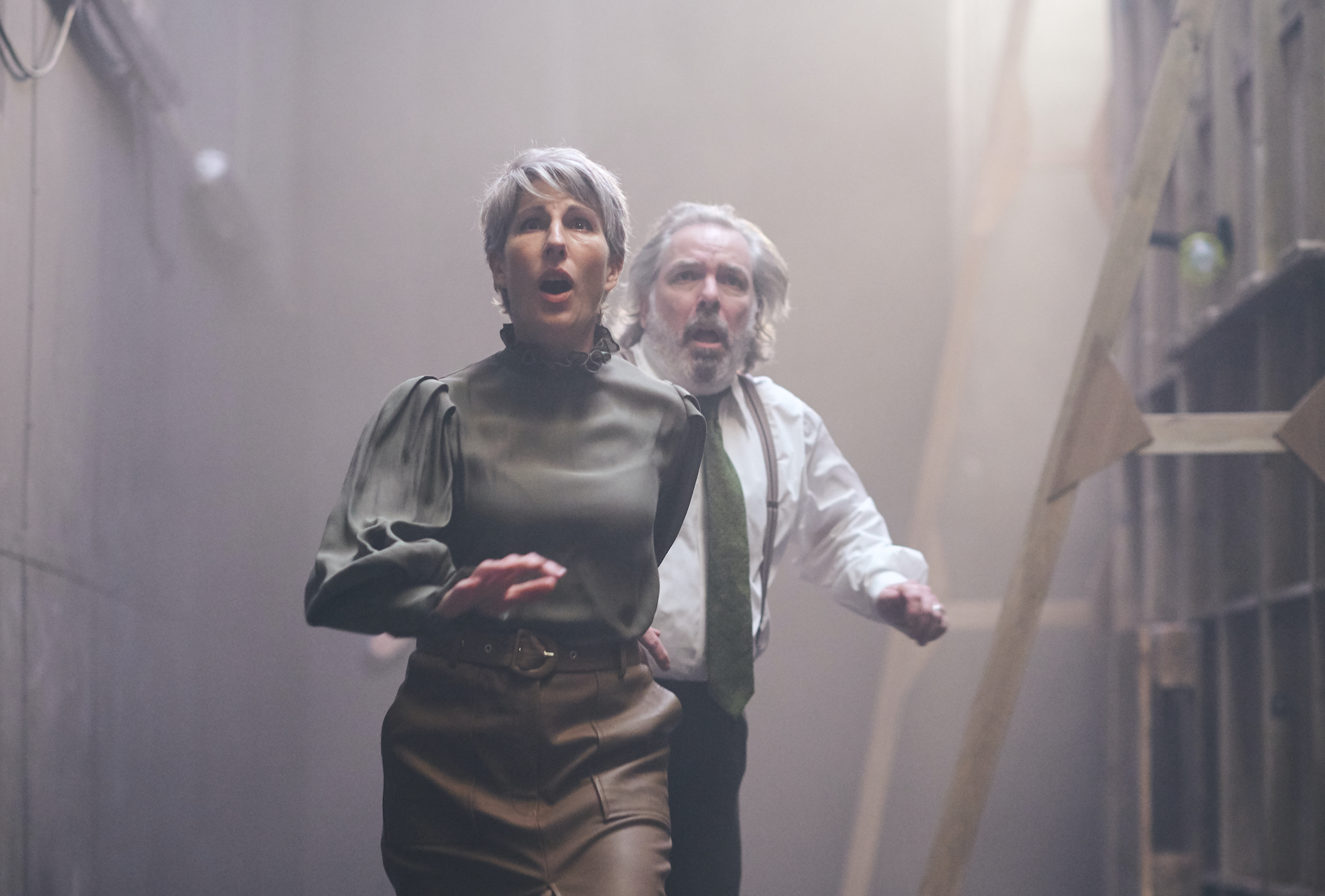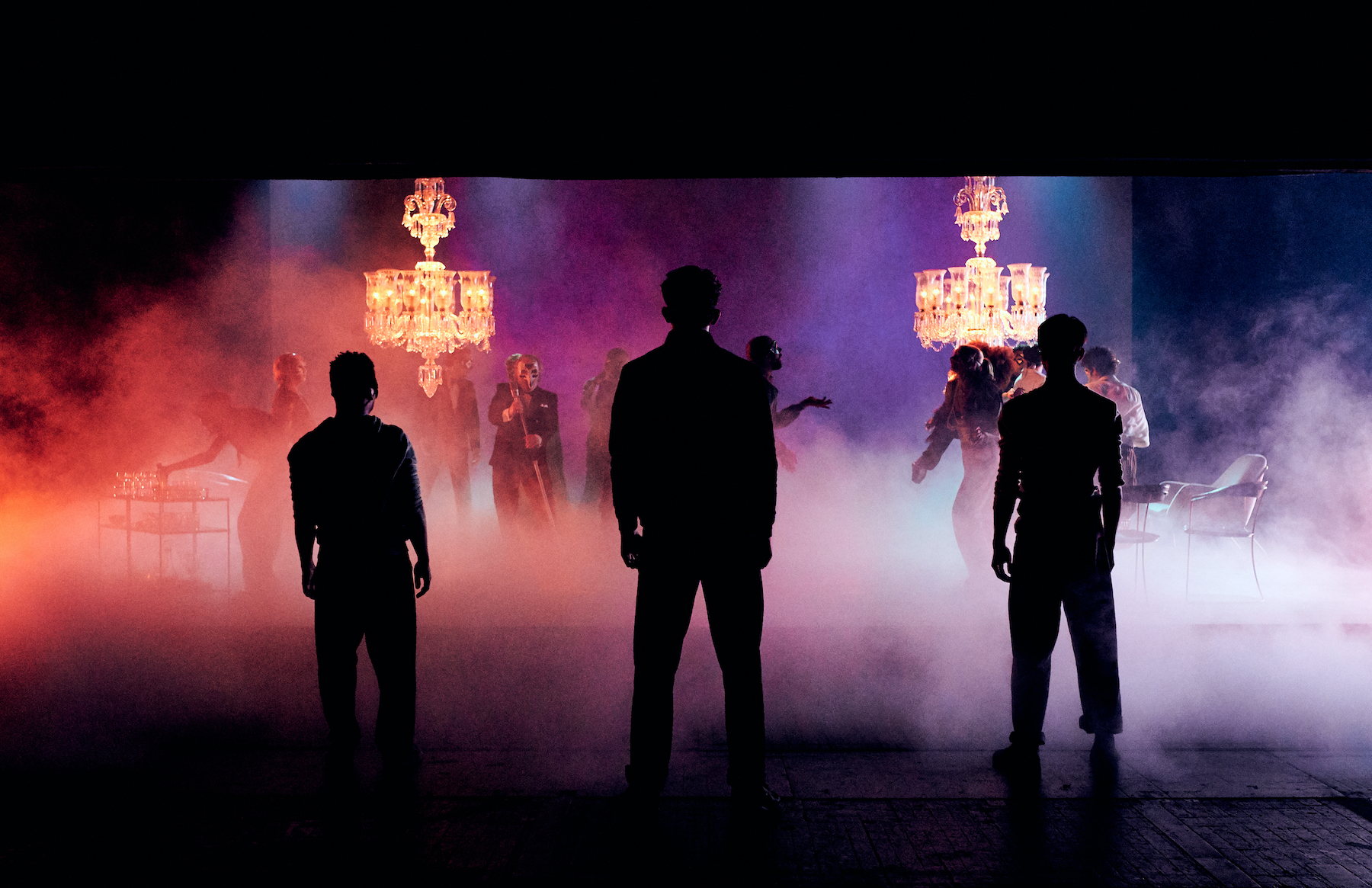Fitting a full, five-act Shakespeare play into a condensed time frame is always a dubious task. After centuries of both tradition and refinement, there’s a constant question of what lies at the heart of these works and what makes them essential. Any process of winnowing, especially with foundational texts, runs a risk.
But the most recent film version of “Romeo & Juliet,” airing this week as part of PBS’ long-running “Great Performances” series, gains something profound in separating this cultural touchstone into its component parts. In the process, the title couple (played by incipient megastars Jessie Buckley and Josh O’Connor) and their long-ingrained tragedy play out in an elemental form. It’s a version — from director Simon Godwin and adapter Emily Burns — that imagines a more self-aware couple, a pair that seems to anticipate their star-cross’d fate even more than most incarnations.
That begins in the opening, which follows the cast into a kind of hollowed-out performance space, with a superb Lucian Msamati as the Chorus (before settling into his main role as Friar Lawrence) offering the iconic plot overview like a director before a table read. As the members of the ensemble all make eye contact and show various levels of first-rehearsal jitters, they set about the action that, from the first thumb-biting standoff, slowly begins the stage’s gradual transformation from an empty square into a familiar parade of locations.
Those include more dramatic updates (the party where the lovers first meet is a Capulet rave where Juliet sings on stage over a thumping beat) and slight twists on established classics (O’Connor carries over a plain ladder so he can climb to the balcony). There are enough establishing shots to mark the passage between scenes, but there’s an intimacy in the camera placement that relishes in being as close as possible to each interaction. It’s not so sparse as to be fully deconstructed, but this is a version that’s hyper-focused on boiling down to what’s absolutely necessary.

“Romeo & Juliet”
Rob Youngson
Godwin and Burns have done a fascinating job in not only helping to devise the execution of these alterations, but in an exacting way that puts even more focus on the play’s foundational component parts. The soliloquies are pared down to a minimum, the Mab-length speeches distilled down to their essences, and some minor roles excised entirely (much to this guy’s dismay). What exists in their place is some room for the kind of physical and emotional catharsis that’s centered solely in Buckley and O’Connor’s expressions.
Woven throughout are split-second visions of the tragedies to come. Over time, there’s sorrow in the outcome, but it’s almost as if Juliet in particular is grief-stricken over the idea that she can’t escape what’s out of her control.
Though this is Godwin’s first time directing a film, this production benefits from an ensemble very familiar with untethering Shakespeare from traditional stagings. “Hamlet” alone has provided plenty of these opportunities, from the Godwin-directed 2016 production that transposed the drama to a West African setting to the masterful 2018 Globe production that featured a riveting Shubham Saraf as Ophelia (he plays Benvolio here).
Aside from the sparse, minimalist sets, the biggest example of this particular “Romeo & Juliet” embrace of fluidity comes in its approach to Juliet’s parents, here mostly swapping the dialogue traditionally reserved for “Capulet” and “Lady Capulet.” Tamsin Grieg takes this refashioned mantle, who molds the role of Capulet into a head of household who trades boisterousness for more exacting matriarchal control. She’s a natural fit, reteaming with Godwin after a National Theatre “Twelfth Night” — watching her character try to manipulate the fortunes and futures of others is just as potent here as it was with Malvolia.

“Romeo & Juliet”
Rob Youngson
A short looking at the making of this production, part of the “Great Performances” block and available to watch online, details how it came together during last year’s theater shutdown. Even without knowledge of the circumstances playing out just beyond the theater’s walls, there is a sort of eerie, unmoored-from-time feeling that comes from how this “Romeo & Juliet” shuffles its design elements. The bevy of candles surrounding the blissful couple, the giant flat moon, Friar Lawrence’s meticulous brewing of Juliet’s sleeping potion: all play up the theatrical foundation of this telling as it’s being filtered through film language. Even the assemblage of costumes, fitting though they are for this atmosphere, reach across generations. It adds to an idea baked into the production’s DNA, of a (“Station Eleven”-like) band of artists brought together in uncertain times, using only the tools at their immediate disposal.
Another piece of connective tissue is the music, a near-constant presence, also helping to fill in the spaces that the empty dialogue spaces leave. Buckley’s own voice is woven into the ether of the score, as images of Romeo and Juliet’s romance plays out in both passion and playfulness. (For good measure, a late scene of non-verbal mourning also gets a dramatic assist from one of the great symphonic works of the last half-century.)
Maybe the most effective creative choice that “Romeo & Juliet” is staging multiple scenes that feature characters who wouldn’t otherwise be on stage. They range from a plotting Paris (Alex Mugnaioni) staring from a distance to sequences where the entire cast encircles someone in a moment of crisis. That’s all reflected in one of the opening shots, the entire company glimpsed through a sliver in the wall. Here, “Romeo & Juliet” is both a presentation and a kind of secret, one that’s all the more entrancing by what it chooses to leave hidden.
“Romeo & Juliet” airs on Friday night at 9 p.m. as part of PBS’ “Great Performances.”
But the most recent film version of “Romeo & Juliet,” airing this week as part of PBS’ long-running “Great Performances” series, gains something profound in separating this cultural touchstone into its component parts. In the process, the title couple (played by incipient megastars Jessie Buckley and Josh O’Connor) and their long-ingrained tragedy play out in an elemental form. It’s a version — from director Simon Godwin and adapter Emily Burns — that imagines a more self-aware couple, a pair that seems to anticipate their star-cross’d fate even more than most incarnations.
That begins in the opening, which follows the cast into a kind of hollowed-out performance space, with a superb Lucian Msamati as the Chorus (before settling into his main role as Friar Lawrence) offering the iconic plot overview like a director before a table read. As the members of the ensemble all make eye contact and show various levels of first-rehearsal jitters, they set about the action that, from the first thumb-biting standoff, slowly begins the stage’s gradual transformation from an empty square into a familiar parade of locations.
Those include more dramatic updates (the party where the lovers first meet is a Capulet rave where Juliet sings on stage over a thumping beat) and slight twists on established classics (O’Connor carries over a plain ladder so he can climb to the balcony). There are enough establishing shots to mark the passage between scenes, but there’s an intimacy in the camera placement that relishes in being as close as possible to each interaction. It’s not so sparse as to be fully deconstructed, but this is a version that’s hyper-focused on boiling down to what’s absolutely necessary.

“Romeo & Juliet”
Rob Youngson
Godwin and Burns have done a fascinating job in not only helping to devise the execution of these alterations, but in an exacting way that puts even more focus on the play’s foundational component parts. The soliloquies are pared down to a minimum, the Mab-length speeches distilled down to their essences, and some minor roles excised entirely (much to this guy’s dismay). What exists in their place is some room for the kind of physical and emotional catharsis that’s centered solely in Buckley and O’Connor’s expressions.
Woven throughout are split-second visions of the tragedies to come. Over time, there’s sorrow in the outcome, but it’s almost as if Juliet in particular is grief-stricken over the idea that she can’t escape what’s out of her control.
Though this is Godwin’s first time directing a film, this production benefits from an ensemble very familiar with untethering Shakespeare from traditional stagings. “Hamlet” alone has provided plenty of these opportunities, from the Godwin-directed 2016 production that transposed the drama to a West African setting to the masterful 2018 Globe production that featured a riveting Shubham Saraf as Ophelia (he plays Benvolio here).
Aside from the sparse, minimalist sets, the biggest example of this particular “Romeo & Juliet” embrace of fluidity comes in its approach to Juliet’s parents, here mostly swapping the dialogue traditionally reserved for “Capulet” and “Lady Capulet.” Tamsin Grieg takes this refashioned mantle, who molds the role of Capulet into a head of household who trades boisterousness for more exacting matriarchal control. She’s a natural fit, reteaming with Godwin after a National Theatre “Twelfth Night” — watching her character try to manipulate the fortunes and futures of others is just as potent here as it was with Malvolia.

“Romeo & Juliet”
Rob Youngson
A short looking at the making of this production, part of the “Great Performances” block and available to watch online, details how it came together during last year’s theater shutdown. Even without knowledge of the circumstances playing out just beyond the theater’s walls, there is a sort of eerie, unmoored-from-time feeling that comes from how this “Romeo & Juliet” shuffles its design elements. The bevy of candles surrounding the blissful couple, the giant flat moon, Friar Lawrence’s meticulous brewing of Juliet’s sleeping potion: all play up the theatrical foundation of this telling as it’s being filtered through film language. Even the assemblage of costumes, fitting though they are for this atmosphere, reach across generations. It adds to an idea baked into the production’s DNA, of a (“Station Eleven”-like) band of artists brought together in uncertain times, using only the tools at their immediate disposal.
Another piece of connective tissue is the music, a near-constant presence, also helping to fill in the spaces that the empty dialogue spaces leave. Buckley’s own voice is woven into the ether of the score, as images of Romeo and Juliet’s romance plays out in both passion and playfulness. (For good measure, a late scene of non-verbal mourning also gets a dramatic assist from one of the great symphonic works of the last half-century.)
Maybe the most effective creative choice that “Romeo & Juliet” is staging multiple scenes that feature characters who wouldn’t otherwise be on stage. They range from a plotting Paris (Alex Mugnaioni) staring from a distance to sequences where the entire cast encircles someone in a moment of crisis. That’s all reflected in one of the opening shots, the entire company glimpsed through a sliver in the wall. Here, “Romeo & Juliet” is both a presentation and a kind of secret, one that’s all the more entrancing by what it chooses to leave hidden.
Grade: A-
“Romeo & Juliet” airs on Friday night at 9 p.m. as part of PBS’ “Great Performances.”

